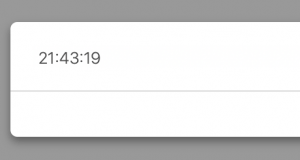
You need to get through the waiting period milliseconds means to wait a second you need to pass a thousand milliseconds. JavaScript setTimeout() method is a built-in method that allows you to time the execution of a function. clearInterval The setTimeout(function, delay) function is used to start a timer that calls a particular function after the mentioned. It may be helpful to be aware that setInterval() and setTimeout() share the same pool of IDs, and that clearInterval() and clearTimeout() can technically be used interchangeably.
#SET TIMER JAVASCRIPT CODE#
If you have a lot setTimeout() methods, then you need to save the IDs returned by each method call and then call clearTimeout() method as many times as needed to clear them all. working of timers in javascript Timers are used to execute a piece of code at a set time or also to repeat the code in a given interval of time. The returned intervalID is a numeric, non-zero value which identifies the timer created by the call to setInterval() this value can be passed to clearInterval() to cancel the interval. Similarly you can stop the setTimeout () by using clearTimeout () method.

You can stop the interval by using the clearInterval () method. Whereas you can notice that the setInterval () function will keep calling the callback function after every 1 seconds repeatedly.
#SET TIMER JAVASCRIPT HOW TO#
To clear or cancel a timer, you call the clearTimeout() method, passing in the timer object that you created into clearTimeout().įor example, the code below shows how to properly clear a timer inside of a functional React component.For example, the code below will print “Hello World” to the JavaScript console after 2 seconds have passed: setTimeout(function() has been cleared`) clearTimeout() method is working You can use setTimeout () to show a popup or overlay after a specific or set time. Third, use CSS flexbox to set the countdown app to the centre of the screen by selection class countdown-timer. The following are the two functions provided by JavaScript for this purpose: 1.

However, there are certain in-built functions in JavaScript which allow us to schedule tasks to be executed after a specific amount of time. JavaScript code that set the timer of 2 minutes and when the times up the Page alert times up. Return Value: It returns a number representing the ID value of the timer that is set. parameter1: It is additional parameters to pass to the function and it is optional. Second, set background image which you downloaded above to the body and set background-size: cover. How to set a timer in JavaScript Educative Answers Team In JavaScript, the code is executed asynchronously. It is optional and its default value is zero (0). Clearing setTimeoutĪ setTimeout timer must be cleared and handle properly, otherwise, you may experience adverse side effects in your code. First, set browsers default margin and padding to 0 by selection all using. setTimeout() will return the timeoutID which is a positive integer and unique ID for the. You can also have optional arguments that are passed into the function. If the delay is omitted from the setTimeout() method, then the delay is set to 0 and the function will execute. that is, you have to determine for what time you want to run the countdown. First of all, we have set a specific date with the help of Date.parse. Now I have implemented this javascript countdown timer with the help of JavaScript. We schedule a new setTimeout called timer when the App component mounts for the first time.Īs a result, the code inside of the setTimeout block runs after 1 second as indicated by the 1000 millisecond value that’s passed into the second parameter of the setTimeout method. The delay is set in milliseconds and 1,000 milliseconds equals 1 second. The following are the two functions provided by JavaScript for this purpose: 1. Step 2: Activate it using JavaScript code.

 Create a < span> element for each so that later you can target them with JavaScript.
Create a < span> element for each so that later you can target them with JavaScript. #SET TIMER JAVASCRIPT UPDATE#
Because of how JS engines work, if you put Timer in a loop, to run for an infinite period of time, youd never see the time update on the screen (as changes arent drawn to the window until a function finishes and theres a gap in the program). The countdown timer will display four figures: days, hours, minutes, and seconds. Lets take a look at the syntax of this method. Making a real-time clock is impossible in JS. The setTimeout() method executes a particular function after a specific amount of time has elapsed. If you want to learn more about Hooks, I recommend my tutorial on Simplifying Forms using React Hooks. The clock is recursively calling itself, after the elapsed period of time. Our functional component runs the useEffect method when it first renders.


 0 kommentar(er)
0 kommentar(er)
